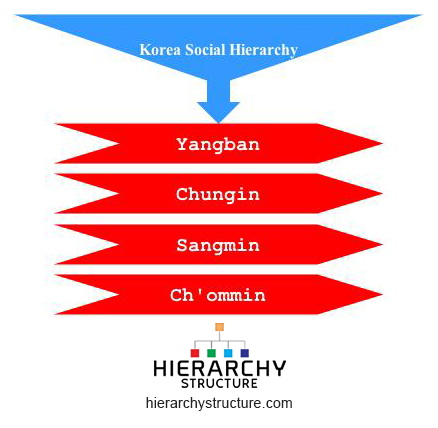The social structure of modern South Korea is a reflection of the impact of diverse cultures including both foreign and indigenous. The Choson Dynasty rulers of Korea adopted the NeoConfucian doctrine as their state philosophy and the Korean neo-Confucian philosopher, Yi Hwang was a great influence on the later Confucianists generations.
Under this dynasty, the four distinct classes of social hierarchy developed: the yangban or scholar officials; the middle people or chungin who are subordinates to the yangban; the largest group of commoners or sangmin which comprises of farmers, merchants etc. and the ch’ommin at the lowest in the social spectrum.
 Yangban
Yangban
In the Korean social hierarchy, the yangban refers to the elite class of office holders or government officials who had passed the prestigious civil service examinations based on the Confucian classics and their neo-Confucian interpreters. Over a period of quite a few generations, the yangban lineage has been the one that was synonymous with prestigious appointments in government services as well as examination successes.
There were two groups inn yangban class itself: one that comprises of scholars and officials and the second group comprises of remote relatives of these officials who, in spite of being poor held the same elite position as long as they engaged Confucian culture and rites. The yangban class generally achieved their positions through educational success and were considered meritocratic elite.
Chungin
The chungin class is lower to the yangban in the social hierarchy and above the commoners, and is comprised of small cluster of technical and secretarial officials. This is inclusive of interpreters, physicians, astronomersand artists as well as specialized military officers. These native bureaucrats, who belonged to a lower hereditary classwere a significant and a frequently plagued connection between the commoners and the yangban class.
Sangmin
The vast majority of around 75% of the Korean population belongs to the Sangminor commoners class in the social hierarchy. Common merchants, farmers and craftsmen belong to this class and they bear the burden of. They were subject to military enrolment as well and live a hard life compared to yangban and chungin. In the social hierarchy, although the farmers enjoyed a higher prestige than merchants they nonetheless lived a tough life.
Ch’ommin
The base people or Ch’ommin are considered below the commoners and they normally do the despicable or low grade jobs. This class is inclusive of the slaves and servants in the government offices actors, jail keepers and convicts, female entertainers (kisaeng), shamans, shoemakers, Buddhist monks and nuns, professional mourners, and executioners.
The group known as paekchong are also included in this class, who are believed to be derived from Inner Asian Nomads and are engaged in ‘unclean jobs’ like dealing with hides of animals and meat. This class usually live as a segregated community in the Korean social life. Many of this class divisions are officially obliterated by the end of nineteenth century. The recent decades saw numerous changes in the social classes and lives in the Korean community.
know about North Korea social hierarchy
